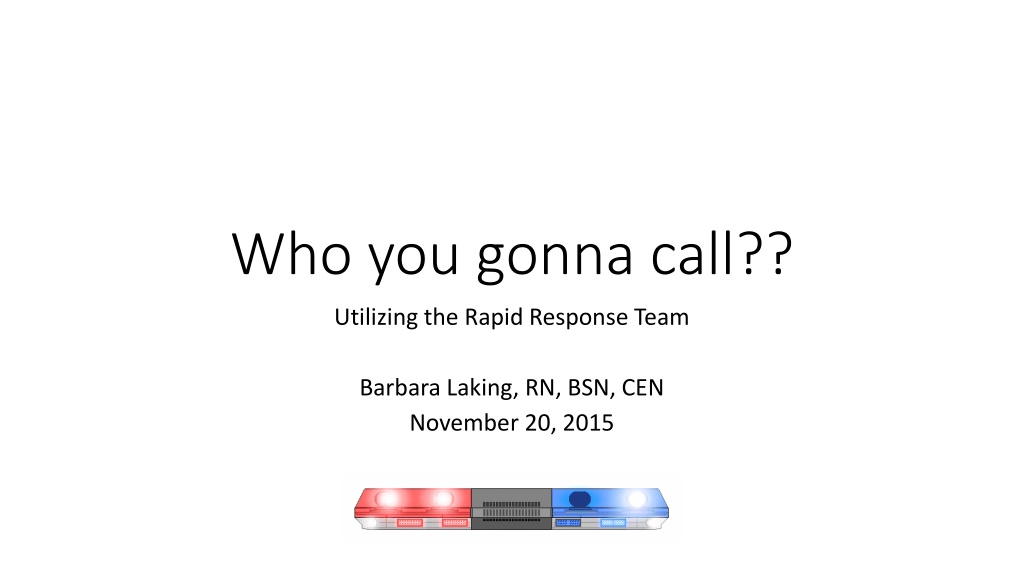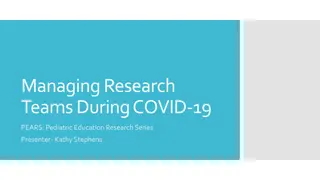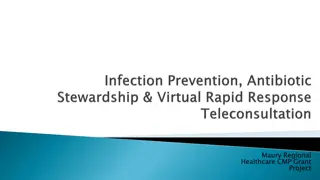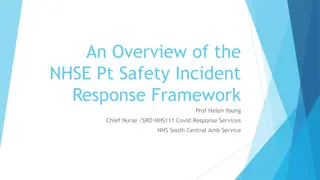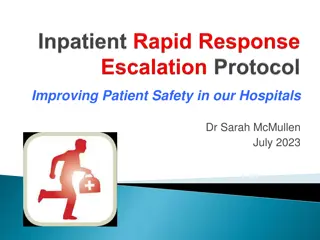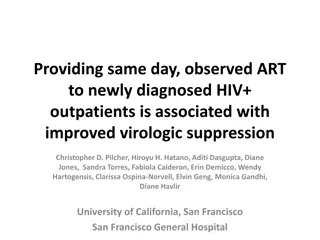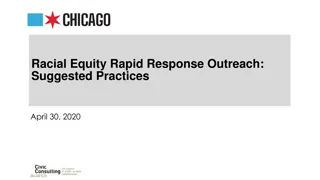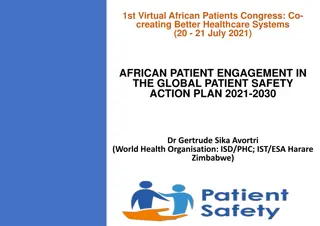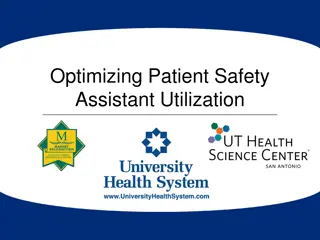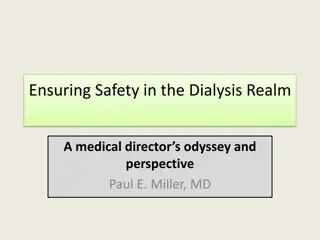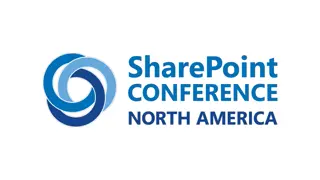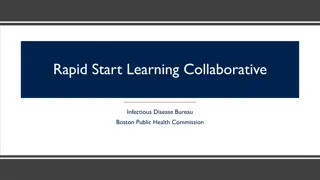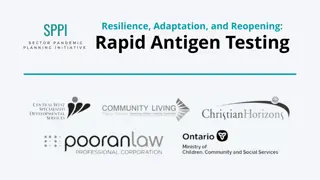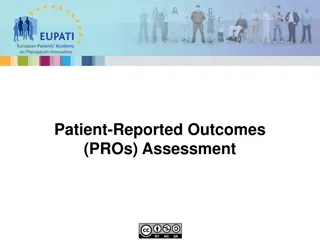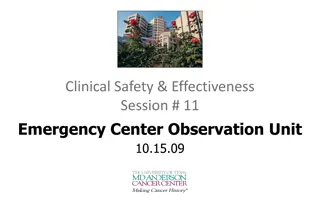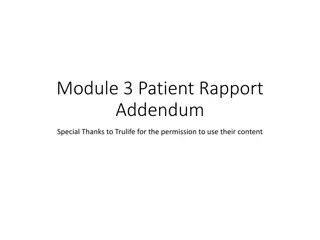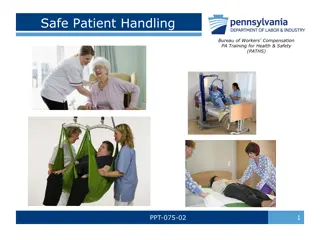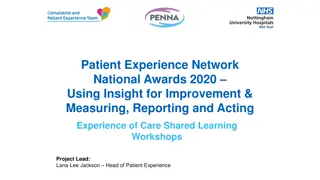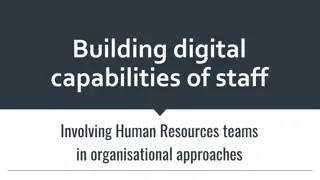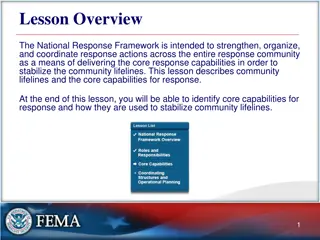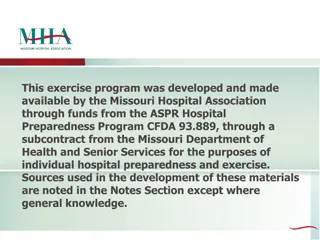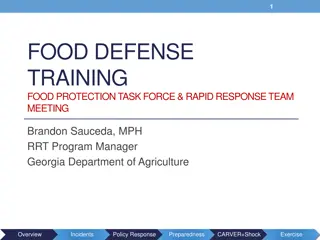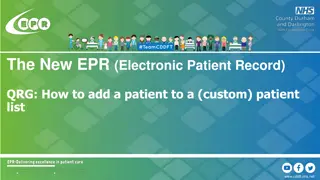Enhancing Patient Safety Through Rapid Response Teams: A Historical Perspective
Exploring the evolution of Rapid Response Teams in healthcare, starting from the 100,000 Lives Campaign to the addition of new quality initiatives aimed at preventing patient harm and improving outcomes. The emphasis is on early recognition of patient deterioration to prevent failure to rescue scenarios and enhance overall patient safety.
Uploaded on Oct 04, 2024 | 0 Views
Download Presentation

Please find below an Image/Link to download the presentation.
The content on the website is provided AS IS for your information and personal use only. It may not be sold, licensed, or shared on other websites without obtaining consent from the author. Download presentation by click this link. If you encounter any issues during the download, it is possible that the publisher has removed the file from their server.
E N D
Presentation Transcript
Who you gonna call?? Utilizing the Rapid Response Team Barbara Laking, RN, BSN, CEN November 20, 2015
History of Rapid Response Teams The Institute of Healthcare Improvement did a study in the early 21st century that estimated that about 98,000 patients die each year from medical mistakes. This launched a current patient safety and quality movement 100, 000 LIVES CAMPAIGN The idea was pretty straightforward: implement quality initiatives and save the lives of 100,000 patients as a result
The Quality Initiatives Deploy Rapid Response Teams at the first sign of patient decline Deliver reliable evidence-based care for AMI patients to prevent death Prevent adverse drug events by implementing medication reconciliation Prevent surgical site infections by delivering perioperative antibiotics at the appropriate time Prevent central line infections by implementing a central line bundle Prevent ventilator-associated pneumonia by implementing a ventilator bundle
5 Million Lives Saved The Institute of Healthcare Improvement (IHI) adds 6 MORE quality initiatives: Prevent pressure ulcers Reduce MRSA infections Prevent harm from HIGH ALERT medications Reduce surgical complications Deliver evidence-based care for congestive heart failure Get Boards on board
SO.in 2008 JCHO added a National Patient Safety Goal requiring hospitals to create and implement a method that enables healthcare staff members to directly request additional assistance from a specially trained individual when a patient s condition appears to be deteriorating
Failure to Rescue Failure to Rescue is associated with the failure to recognize early changes in a patient s condition and acting too late to improve patient outcomes which can lead to major complications up to and including death. The phrase is not intended to imply negligence or wrongdoing
Impending arrest In 2007, 16% of all hospital patients would have experienced a cardiac arrest In 2008, the IHI indicated that cardiac arrest in hospitals was usually preceded by OBSERVABLE signs of deterioration 6-8 hours before the arrest occurred 70% of such events are preventable Survival rate to discharge after a full arrest is 15%
The Rapid Response Team is born!! Today s Rapid Response Teams are an established Standard of Care that promote Patient Safety
The difference RRT makes 50% reduction in out of ICU arrests Significant reduction in post-op emergency transfers (58%) and deaths (37%) Reduction in arrest prior to ICU transfer Reduction in the number of patients who expire in the hospital as well as the number of Code Blues called IHI, 2008
At Covenant Healthcare the Rapid Response Team is the REACH Team. Rapid Evaluation At Covenant Healthcare
REACH team At Covenant Healthcare the REACH team consists of: A REACH nurse (extensive Critical Care and/or Emergency experience) A Registered Respiratory Therapist A Hospitalist (who is involved based on patient acuity and provider availability) Other institutions may have a different make-up: ICU RN, RRT, Intensivist or Hospitalist ICU RN and RRT ICU RN, RRT, Intensivist, Resident ICU RN, RRT, PA ED or ICU RN
The Purpose of the REACH Team The purpose of this team is to assist the bedside nurse in evaluating patient s condition by identifying early signs and symptoms of patients deteriorating status and perform appropriate interventions expeditiously. To decrease unexpected mortality by early recognition of a patient s deterioration and intervening before the patient either arrests or requires transfer to a critical care unit.
Why call the RRT/REACH Team? There are hundreds of reasons to make a REACH call, a few of our favorites: Airway Breathing Circulation Neurology Nurse Concern Sepsis
Airway issues Any time your patient s airway is or could be threatened Excessive secretions Vomitus Bleeding
Breathing issues Shortness of Breath Respiratory Rate <8 or >30 O2 Sat < 90% despite O2 And just to be safe, call if you have to increase O2 as well
Hypotension is the NUMBER TWO precursor to a code
Circulation issues BP < 90 or > 200 HR < 50 or > 130 Uncontrolled Bleeding Sustained Arrhythmia or EKG Changes New Onset of Chest Pain
Neurology issues Motor or sensory dysfunction or seizures CIWA score > 8 after 2 interventions Changes in LOC NIHSS Scale completion (REACH nurses are NIHSS certified) Signs/symptoms of stroke (REACH nurses can activate a Code 180)
Nurse concern Gut instinct Something isn t right I don t know the next step to take I need someone else to look at him/her There are no stupid questions No call is inappropriate
Sepsis If there is confirmed or presumed infection and 2 SIRS criteria: Temp >100.4 or <96.8 HR > 90 beats/min RR > 20 breaths/min WBC > 12,000 or < 4,000/mm3 or >10% bands PLUS: Organ dysfunction Altered LOC Oliguria Hyperglycemia (without DM) Hypotension
What should you expect when you call the RRT? Get ready- here we come!! Have a current set of VS- including a chemstrip Put the patient on a monitor Calculate a GCS (or at least be able to speak to patient s baseline) Have a functioning IV, please and thank you Oxygen STAY WITH YOUR PATIENT
The REACH nurse is not going to take over the situation- you are the primary nurse and you have been caring for the patient DO NOT LEAVE THE BEDSIDE unless you are calling either family or the physician FOLLOW UP-FOLLOW UP-FOLLOW UP-FOLLOW UP-FOLLOW UP-FOLLO VS including temp and pulse ox in 15 min and Q1H x2 after the call Document! The REACH nurse may not be on your unit but will likely pop into the chart Monitor for lab and x-ray results ordered during a call If it s a full moon or Friday or . The REACH nurse may not be able to look at all the lab results Complete a focused assessment in 1-2 hours
Talking to the physician DO YOUR HOMEWORK FIRST It s all about the communication Be direct and to the point Tell them why you are calling State what you think is the problem Don t settle for inappropriate responses (CUUS) I m Concerned I m Uncomfortable This feels Unsafe I m Scared
Sometimes we have to lead gently Would you like me to do this or that . Do you want me to start the recommended . How do you feel about . Help me to understand .
We know why RRTs started We know why to call a REACH call We know that there is going to be someone with a wealth of knowledge and critical thinking coming to help Lets look at some scenarios ..
CASE EXAMPLE Your 60 yo male patient recently underwent abdominal surgery and had an uneventful hospital course, he returned to his surgeon s office c/o SOB and CP. The physician sent him in as a direct admit. He was stable upon leaving the office but arrives to your floor SOB and diaphoretic with a pulse ox of 84% on RA. Now what???
Pulmonary Embolism?? PEs are the most common preventable cause of in-hospital death Risk factors include venous stasis, vessel trauma, and hypercoagulability You and the REACH RN find that the patient has been less than mobile and his surgery was related to a cancer diagnosis The REACH nurse coaches you through the call to the physician. Your patient immediately gets the tests and supportive treatment needed
CASE EXAMPLE Your 57 yo female patient was admitted with c/o intractable abdominal pain. She is being treated for pancreatitis. She began c/o heartburn about a half hour ago- states it is very different from the abd pain she came in with. The NCA was just in updating vitals and reports that the patient is now c/o the pain going up into her throat. You just don t feel right about the situation. Now what????
MYOCARDIAL INFARCTION??? You page a REACH call and the REACH nurse asks you to attach the patient to a tele monitor- you re not 100% sure but things look off Upon the REACH nurse arrival S/he orders an EKG STAT and confirms a STEMI TIME IS MUSCLE!!! The REACH nurse speaks with a physician and cardiologist and the patient is taken to the CCL for intervention
CASE EXAMPLE Your 71 yo female patient has been progressing well following surgery and is ready to be discharged. She has gotten dressed and is awaiting the arrival of her husband to take her home. When he enters the room she is behaving oddly and c/o feeling weak. He thinks she has slurred speech and calls you to the bedside. What now??
STROKE??? TIME IS BRAIN!! You page the REACH call and immediately obtain a chemstrip- it is normal. You were with the patient 30 minutes prior to her husband s arrival and mark that time as the last she was normal You stay with the patient and husband to assist in answering questions and the REACH RN pages a Code 180
CASE EXAMPLE Your 34 yo male patient was admitted yesterday for IV antibiotics due to a wound on his foot which has progressed to cellulitis of the foot and leg. You are meeting him for the first time today during your initial assessment. He is uncooperative and confused. His vitals are pretty much unchanged but his HR has increased to 110-120. Now what???
SEPSIS??? TIME IS TISSUE!! You page a REACH call and recheck your patient s VS. His morning labs are back and his WBC is now 18,000 Your patient has a confirmed infection, HR 120, WBC >12K and now has altered LOC- he has progressed to severe sepsis STAT labs, early initiation of ABX and IVF
CONCLUSION RRTs were created because there was significant data showing there were opportunities to intervene prior to a patient s arrest The purpose of the RRT/REACH team is to assist the bedside nurse in identifying and intervening in a patient s deterioration There are many reasons to page a REACH call but there is no reason NOT to call The goal of the REACH team is to support the bedside nurse and prevent transfer to a higher level of care if it is safe for the patient A REACH call is both an opportunity to help the patient as well as to learn- stay with your patient and with the REACH nurse
